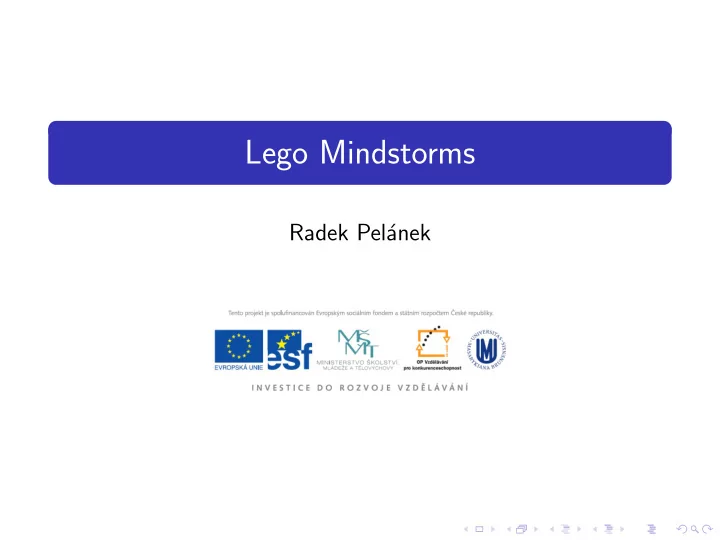

Lego Mindstorms Radek Pel´ anek
Lego Mindstorms produced by Lego, http://mindstorms.lego.com history 1998: RCX brick 2006: NXT brick why? simple, easy to use illustrates main typical features of embedded real-time system
Lego Mindstorms
NXT brick 3 output motor ports 4 input sensor ports USB port, bluetooth loudspeaker buttons display 32-bit ARM7 microcontroller, 256 Kbytes FLASH, 64 Kbytes RAM power source: 6 AA bateries
Sensors touch pressed/released sound measures sound pressure in decibels light measures the light intensity ultrasonic measures distance form an object; 0 to 255 cm, (declared) precision +- 3cm third-party color, compass, temperature, pressure, ...
Motors setting: direction, speed motor synchronization built-in rotation sensor (accuracy +- 1 degree)
Programming Environments type of environment product visual Mindstorms NXT software RoboLab C-like BrickCC, NXC (Not eXactly C) RobotC Java leJOS NXJ Comparison: http://www.teamhassenplug.org/NXT/NXTSoftware.html
leJOS http://lejos.sourceforge.net/ Java based firmware replacement and programming environment Eclipse support Java API for the brick (sensors, motors, ...)
Brick Command Center http://bricxcc.sourceforge.net/ integrated development environment only under Windows supports all Mindstorms bricks programing for NXT brick: Next Byte Codes (NBC) – similar to assembler Not eXactly C (NXC) – similar to C runs over standard firmware, own firmware for advanced features
Brick Command Center: Basic Demo Tools: Find Brick Watching the Brick Brick Joystick/Piano
Not eXactly C (NXC) basic syntax similar to C variables, expressions, control flow using the Brick Command Center you can compile and download the code to the brick (Menu → Compile)
NXC: Sensors Sensors = input from environment setting sensor type: SetSensor(IN 1,SENSOR TOUCH) SetSensorTouch(IN 1) you can specify more detail (mode) reading sensor information: basic reading: Sensor(IN 1) ultrasonic sensor: SensorUS(IN 1) more: SensorNormalized, SensorBoolean, ...
NXC: Outputs motors (changes to the environment): OnFwd(OUT AB, 70) OnRev(OUT A, 30) Off(OUT A) RotateMotor(OUT A,speed, angle) many more involved commands sounds: PlayTone, PlayFile display: NumOut, TextOut, GraphicOut
NXC: Tasks, concurrency task = unit of concurrency explicitly declared, up to 255 tasks start = only task main is running task activation, termination: StartTask, StopAllTasks, Precedes, Follows access to motors, sensors — critical sections mutual exclusion support: data type mutex , operations Acquire , Release
NXC: Time NXT has timer with granuality 1/1000 second CurrentTick — the current value of the timer Wait — waits for the specified time SleepTime, SleepTimer , ...
Project: Organization groups of 3-4 students development environment: Brick CC or leJOS deadline: April 30th presentation during the lecture (with slides and demo) documentation ( ∼ 2 pages)
Project: Task there is no exact specification it is part of your task to make up an interesting problem preferably: one hardware architecture, two programs for different behaviours
Minimal Requirements the robot should do something meaningful and understandable (not a sequence of random movements) the robot uses at least: two motors, two sensors, display or sound the implementation uses concurrency (at least two tasks) the implementation has real-time aspects (i.e., the behaviour depends on correct timing)
Project: Suggestions find a ball, pick a ball, take a ball to some destination finding a path through a maze line following with navigation through sound hunter: tries to touch (shoot) a ‘pray’ (e.g., another robot or your hamster) look for inspiration on the web (e.g. “youtube lego mindstorms”)
Teamwork: Advice Divide team role’s among team members, e.g.: boss designer hardware (Lego) engineer software engineer presenter, documentator final report: specify contribution of individual members
What Should You Do Now? (in teams, using concurrency) install Lego Mindstorms and Brick Command Center try few experiments with the brick (viewing sensor values, running motors, ...) look at tutorial examples, try to compile some of them and run them try to write some simple code of your own build a simple robot according to the tutorial discuss the project
Recommend
More recommend